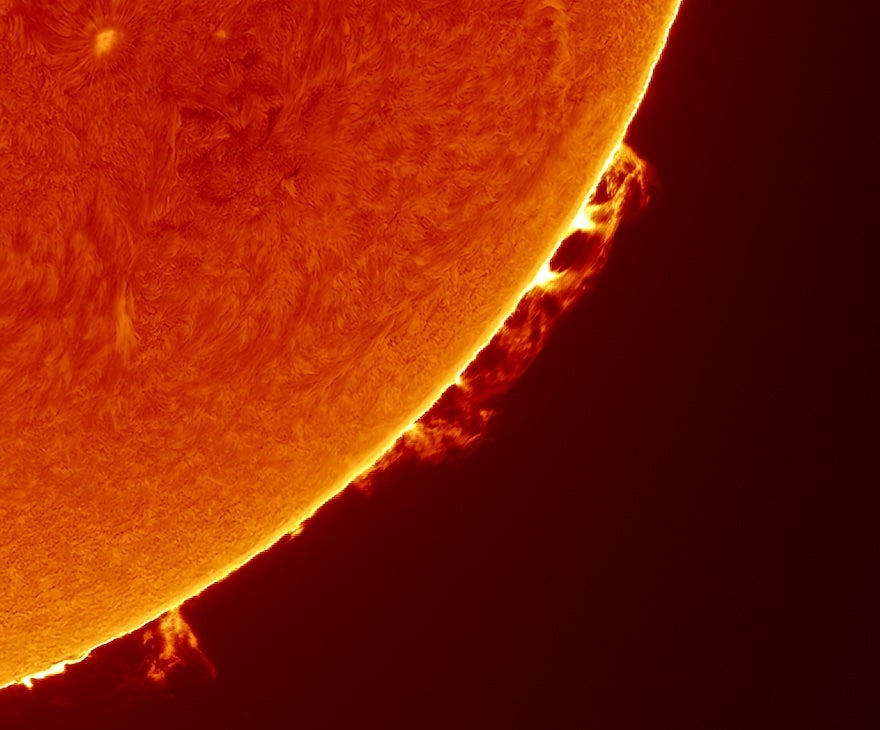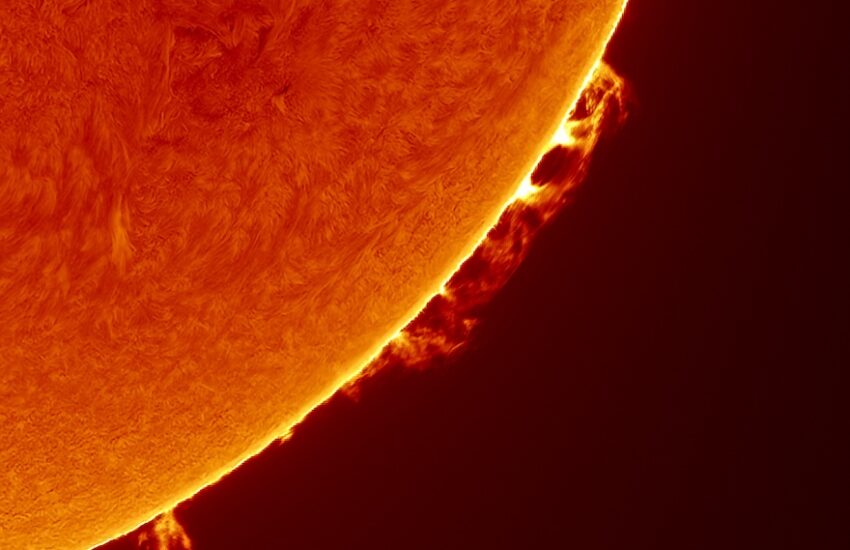
A massive treelike series of prominences sprouts from the Sun’s limb as seen through a Coronado Solarmax III 90mm Double-Stack with a ZWO ASI1600MM Pro. A sunspot and some filaments are also visible. This is a monochrome image that has been artificially colored and inverted for better contrast. Credit: Molly Wakeling
You heard it from your parents. You’ve seen it printed in bold on telescopes. “Do not look at the Sun!” But how can you resist observing the fiery ball of furious fusion that dominates the sky?
Fortunately for the curious among us, there are some safe ways to do just that. And while the total solar eclipse of April 8, 2024, may be in the rearview mirror, the Sun’s 11-year cycle of activity is nearing its peak, so there is plenty to see.
Safe ways to look at the Sun
First, don’t throw away your eclipse glasses! You can use them on any sunny day to get a safe view of the Sun.
But to get a close-up view of our nearest star with a telescope, there are two types of filters you can use. One is a white-light filter, which is a very dark neutral-density filter that blocks 99.999 percent of the Sun’s light. White-light filters can be broken into two categories: glass and film. Glass filters are safer for group events because they are harder to accidentally break or puncture than film. However, the quality of the images they produce is generally not as good as film, and they can be more expensive. Film filters, such as Baader film or mylar, might not look like much, but can provide sharp views of the Sun. Different materials can make the Sun appear different colors, from white, blue, or pink to a “Sun-like” golden yellow. Always be sure to visually inspect for punctures or tears before using a film filter!
The other type of filter is Hydrogen-alpha, or Hα (pronounced “H-alpha”). Unlike white-light filters that let through a wide swath of the optical spectrum, Hα filters pass an extremely narrow slice centered around the 656.281-nanometer wavelength, less than 1 angstrom (0.1 nm) wide. These are much more expensive than white-light filters but provide much greater detail. Because the filter passes only this wavelength, the image appears a vivid red.
There are Hα telescopes designed specifically for observing the Sun, like the Coronado Personal Solar Telescope or the more expensive Lunt telescopes. Alternatively, devices like the DayStar Quark add Hα solar-observing capability to almost any scope. However, note that in such cases a separate energy rejection filter is still required for the front of any nonrefracting telescope and for refractors with apertures larger than 3.2 inches (80mm) to prevent the dangerous buildup of heat.
Solar features to observe

There’s a lot to see on the ever-changing Sun, especially as we approach solar maximum this year. Easiest to spot are sunspots, which are active regions with chaotic magnetic fields in the Sun’s convection layer. They appear darker because they are cooler than the rest of the Sun’s surface by as much as 4,000 degrees Fahrenheit (2,200 degrees Celsius).
With white-light filters, you can primarily see sunspots, as well as plages and faculae — bright areas that sometimes appear around sunspots. White-light filters are great for the partial phases of solar eclipses as they are easy to remove when totality arrives. However, they won’t offer as detailed a view as in Hα.
Hα devices or telescopes allow you to see much more surface granularity. They also reveal prominences: beautiful, towering structures of hot gases that follow magnetic field loops and change constantly. You can spot differences in as little as a few minutes! If you’re lucky, you may catch a massive eruption from the surface, which is sometimes associated with a coronal mass ejection, throwing plasma off into space. Prominences on the surface facing Earth appear as slightly darker structures, called filaments, that span thousands of miles.
Whether you view the Sun in white light or Hα, there is always something to see — and now you can do astronomy 24 hours a day!

